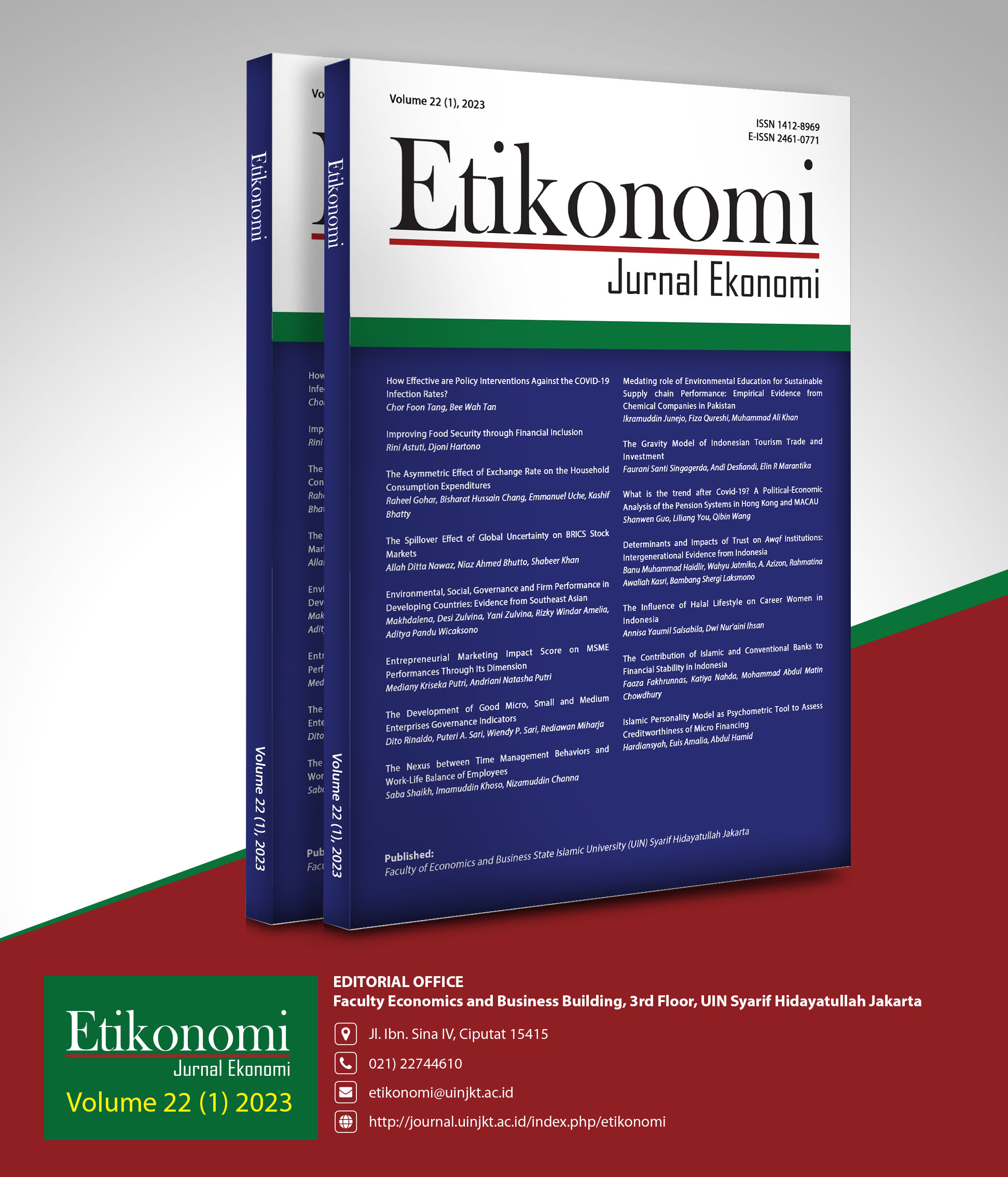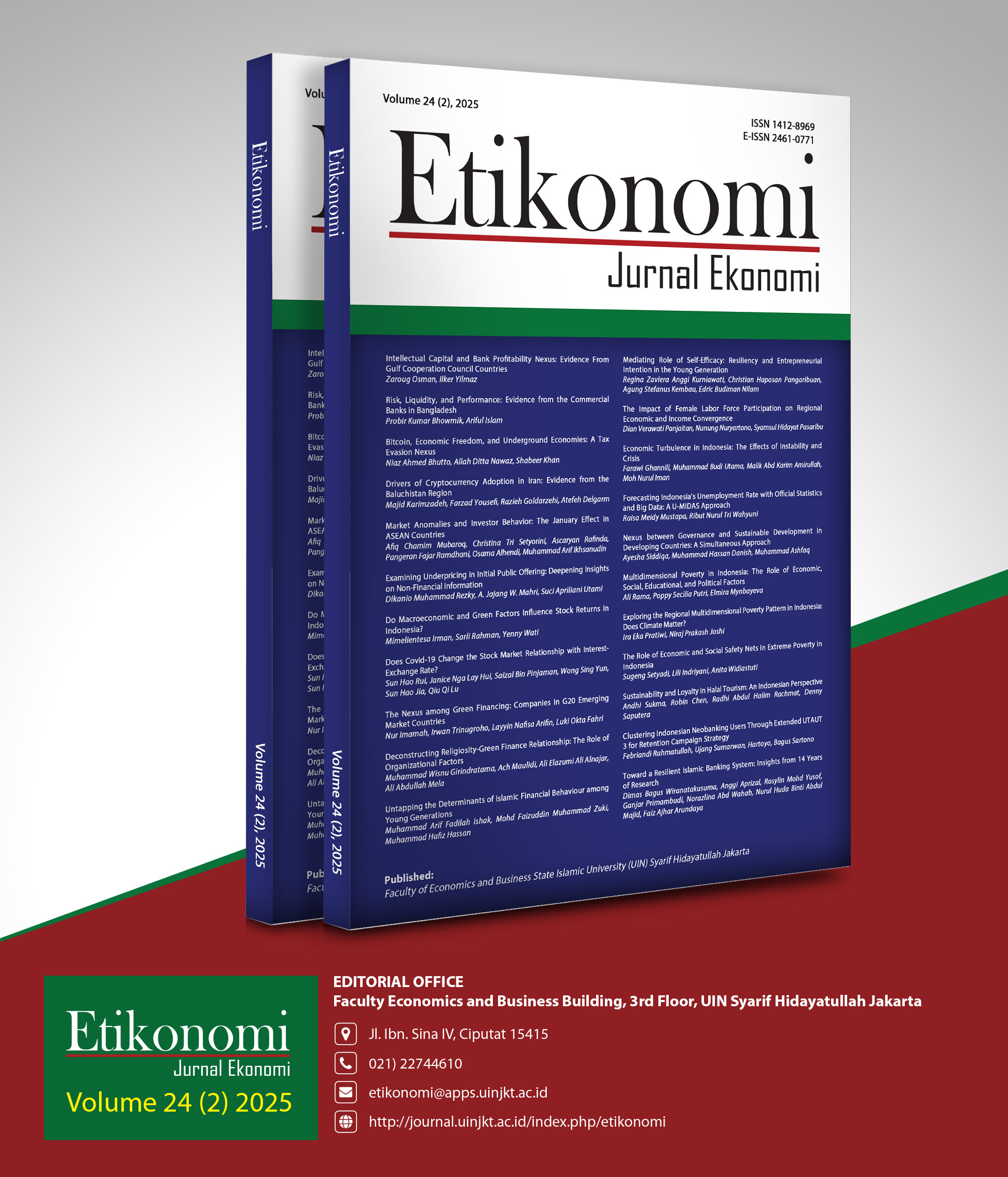The Contribution of Islamic and Conventional Banks to Financial Stability in Indonesia
DOI:
https://doi.org/10.15408/etk.v22i1.26656Keywords:
Islamic bank, conventional bank, NARDL, financial stabilityAbstract
This study aims to examine an asymmetric relationship between Islamic and conventional bank contributions to financial stability in Indonesia. Adopting non-linear autoregressive distributed lag (NARDL), the study utilizes time-series data from 2004m1-2021m9, consisting of financial stability as a dependent variable, proxied by non-performing loans (NPLs) and ZSCORE. Islamic and conventional banks as independent variables were measured by total financing and total assets. Furthermore, we used interest rates and inflation as complementary variables. The findings reveal that Islamic and conventional banks affect financial stability in the short and long run. However, conventional banks contribute to financial stability more than Islamic banks. The asymmetric relationship explains that an increase/decrease in the independent variables to the same degree does not have the same impact on the dependent variable. This research implies that the financial authorities need to increase their awareness of the presence of asymmetric relationships when designing monetary policy to achieve and maintain financial stability. Finally, the study also fills the current research gap by measuring the contribution of Islamic and conventional banks to financial stability from an asymmetric relationship viewpoint.
JEL Classification: E60, G20, G21
How to Cite:
Fakhrunnas, F., Nahda, K., Chowdhury, M.A.M. (2023). The Contribution of Islamic and Conventional Banks to Financial Stability in Indonesia. Etikonomi, 22(1), 213–232. https://doi.org/10.15408/etk.v22i2.26656.
Downloads
References
Albaity, M., Mallek, R. S., & Noman, A. H. M. (2019). Competition and bank stability in the MENA region: The moderating effect of Islamic versus conventional banks. Emerging Markets Review, 38, 310–325. https://doi.org/10.1016/j.ememar.2019.01.003
Ali, M., Haroon, O., Rizvi, S. A. R., & Azmi, W. (2020). Stability versus fragility: New evidence from 84 banks. Studies in Economics and Finance, 38(2), 441–453. https://doi.org/10.1108/SEF-04-2020-0109
Ashraf, D., Ramady, M., & Albinali, K. (2016). Financial fragility of banks, ownership structure and income diversification: Empirical evidence from the GCC region. Research in International Business and Finance, 38, 56–68. https://doi.org/10.1016/j.ribaf.2016.03.010
Asutay, M., & Othman, J. (2020). Alternative measures for predicting financial distress in the case of Malaysian Islamic banks: Assessing the impact of global financial crisis. Journal of Islamic Accounting and Business Research, 11(9), 1827–1845. https://doi.org/10.1108/JIABR-12-2019-0223
Atellu, A. R., Muriu, P., & Sule, O. (2021). Do bank regulations matter for financial stability? Evidence from a developing economy. Journal of Financial Regulation and Compliance, 29(5), 514–532. https://doi.org/10.1108/JFRC-12-2020-0114
Aysan, A. F., & Ozturk, H. (2018). Does Islamic banking offer a natural hedge for business cycles? Evidence from a dual banking system. Journal of Financial Stability, 36, 22–38. https://doi.org/10.1016/j.jfs.2018.02.005
Beck, T. (2015). Cross-Border Banking and Financial Deepening: The African Experience. Journal of African Economies, 24(1), 32–i45. https://doi.org/10.1093/jae/eju028
Belouafi, A., Bourakba, C., & Saci, K. (2015). Islamic finance and financial stability : A review of the literature. JKAU: Islamic Econ., 28(2), 3–44. https://doi.org/10.4197/Islec.28-2.1
Bilgin, M. H., Danisman, G. O., Demir, E., & Amine Tarazi. (2021). Economic uncertainty and bank stability: Conventional vs Islamic banking. Journal of Financial Stability, 56(100911), 1–20.
Bitar, M., Naceur, S. Ben, Ayadi, R., & Walker, T. (2021). Basel Compliance and Financial Stability: Evidence from Islamic Banks. Journal of Financial Services Research, 60(1), 81–134. https://doi.org/10.1007/s10693-020-00337-6
Borio, C. (2011). Rediscovering the macroeconomic roots of financial stability policy: Journey, challenges, and a way forward. Annual Review of Financial Economics, 3(354). https://doi.org/10.1146/annurev-financial-102710-144819
Bussiere, M. (2012). Exchange Rate Pass-through to Trade Prices: The Role of Nonlinearities and Asymmetries. Oxford Bulletin of Economics and Statistics, 75, 731–758. https://doi.org/10.1111/j.1468-0084.2012.00711
Chapra, M. (2011). The global financial crisis: Some suggestions for reform of the global financial architecture in the light of Islamic finance. Thunderbird International Business Review, 53(5), 565-579.
Chen, Y. (2022). Bank Interconnectedness and Financial Stability: The Role of Bank Capital. Journal of Financial Stability, 61, 101019. https://doi.org/10.1016/j.jfs.2022.101019
Crockett, A. (1996). The theory and practice of financial stability. De Economist, 144, 531–568.
Demirgüç-Kunt, A., & Huizinga, H. (2010). Bank activity and funding strategies: The impact on risk and returns. Journal of Financial Economics, 98(3), 626–650. https://doi.org/10.1016/j.jfineco.2010.06.004
Dickey, D. A., & Fuller, W. A. (1981). Distribution of the Estimators for Autoregressive Time Series with a Unit Root. Journal of the American Statistical Association, July 2015, 37–41. https://doi.org/10.1080/01621459.1979.10482531
Elsayed, A. H., Naifar, N., & Nasreen, S. (2022). Financial stability and monetary policy reaction: Evidence from the GCC countries. Quarterly Review of Economics and Finance, 1–11. https://doi.org/10.1016/j.qref.2022.03.003. Volume (issue) number?
Ernst and Young (2016). World Islamic Banking Competitiveness Report 2016. Retrieved from https://ceif.iba.edu.pk/pdf/EY-orldIslamicBankingCompetitivenessReport2016.pdf
Fakhrunnas, F., Nugrohowati, R. N. I., Haron, R., & Anto, M. B. H. (2022). The Determinants of Non-Performing Loans in the Indonesian Banking Industry: An Asymmetric Approach Before and During the Pandemic Crisis. SAGE Open, 12(2), 1–13. https://doi.org/10.1177/21582440221102421
Feghali, K., Mora, N., & Nassif, P. (2021). Financial inclusion, bank market structure, and financial stability: International evidence. Quarterly Review of Economics and Finance, 80, 236–257. https://doi.org/10.1016/j.qref.2021.01.007
Ghassan, H. B., & Guendouz, A. A. (2019). Panel modeling of z-score: Evidence from Islamic and conventional Saudi banks. International Journal of Islamic and Middle Eastern Finance and Management, 12(3), 448–468. https://doi.org/10.1108/IMEFM-04-2018-0122.
Gohar, R., Chang, B. H., Derindag, O. F., & Abro, Z. (2022). Nexus between Consumption, Income and Price Changes: Asymmetric Evidence from NARDL Mode. Etikonomi, 21(2), 213–228. https://doi.org/10.15408/etk.v21i2.23339
Ijaz, S., Hassan, A., Tarazi, A., & Fraz, A. (2020). Linking bank competition, financial stability, and economic growth. Journal of Business Economics and Management, 21(1), 200–221. https://doi.org/10.3846/jbem.2020.11761
IMF (2017). Increasing Resilience to Large and Volatile Capital Flows: The Role of Macroprudential Policies. (IMF Policy Paper).
Jokipii, T., & Monnin, P. (2013). The impact of banking sector stability on the real economy. Journal of International Money and Finance, 32, 1–16. https://doi.org/10.1016/j.jimonfin.2012.02.008
Kabir Hassan, M., Ijaz, M. S., & Khan, M. H. (2021). Bank competition–stability relations in pakistan: A comparison between Islamic and conventional banks. International Journal of Business and Society, 22(2), 532–545. https://doi.org/10.33736/ijbs.3733.2021
Kabir Hassan, M., Khan, A., & Paltrinieri, A. (2018). Liquidity Risk, Credit Risk and Stability in Islamic and Conventional Banks. Research in International Business and Finance. https://doi.org/10.1016/j.ribaf.2018.10.006 Volume/issue/page numbers?
Kabir, M. N., Worthington, A., & Gupta, R. (2015). Comparative credit risk in Islamic and conventional bank. Pacific Basin Finance Journal, 34, 327–353. https://doi.org/10.1016/j.pacfin.2015.06.001
Kasri, R. a., & Azzahra, C. (2020). View of Do Islamic banks more stable than conventional banks_ Evidence from Indonesia. Jurnal Ekonomi & Ekonomi Islam, 6(2), 149–164.
Khattak, M. A., Hamid, B. A., Islam, M. U., & Ali, M. (2021). Competition, Diversification, and stability in the Indonesian banking system. Bulletin of Monetary,Economics and Banking, Special Issue, 59–88.
Kim, H., Batten, J. A., & Ryu, D. (2020). Financial crisis, bank diversification, and financial stability: OECD countries. International Review of Economics and Finance, 65, 94–104. https://doi.org/10.1016/j.iref.2019.08.009
Korbi, F., & Bougatef, K. (2016). Regulatory capital and stability of Islamic and conventional banks. International Journal of Islamic and Middle Eastern Finance and Management, 10(3), 312–330.
Louhichi, A., Louati, S., & Boujelbene, Y. (2019). Market-power, stability and risk-taking: An analysis surrounding the riba-free banking. Review of Accounting and Finance, 18(1), 2–24. https://doi.org/10.1108/RAF-07-2016-0114
Mande, B. T., Salisu, A. A., Jimoh, A. N., Dosumu, F., & Adamu, G. H. (2020). Financial stability and income growth in emerging markets. Bulletin of Monetary Economics and Banking, 23(2), 201–220.
Mateev, M., Moudud-Ul-Huq, S., Sahyouni, A., & Tariq, M. U. (2022). Capital regulation, competition and risk-taking: Policy implications for banking sector stability in the MENA region. Research in International Business and Finance, 60, 101579. https://doi.org/10.1016/j.ribaf.2021.101579
Miah, M. D., Kabir, M. N., & Safiullah, M. (2020). Switching costs in Islamic banking: The impact on market power and financial stability. Journal of Behavioral and Experimental Finance, 28, 100409. https://doi.org/10.1016/j.jbef.2020.100409
Mohamad, A. A. S., Mohamad, M. T., & Hashim, S. A. (2018). Islamic versus conventional banking: Characteristics and stability analysis of the Malaysian banking sector. In New Developments in Islamic Economics: Examples from Southeast Asia (pp. 197–214). https://doi.org/10.1108/978-1-78756-283-720181013 Give editor/s if applicable
Nair, A. R., & Anand, B. (2020). Monetary policy and financial stability: Should central bank lean against the wind? Central Bank Review, 20(3), 133–142. https://doi.org/10.1016/j.cbrev.2020.03.006
Nosheen, & Rashid, A. (2021). Financial soundness of single versus dual banking system: explaining the role of Islamic banks. Portuguese Economic Journal, 20(1), 99–127. https://doi.org/10.1007/s10258-019-00171-2
Olson, D., & Zoubi, T. (2017). Convergence in bank performance for commercial and Islamic banks during and after the Global Financial Crisis. Quarterly Review of Economics and Finance, 65, 71–87. https://doi.org/10.1016/j.qref.2016.06.013
Paltrinieri, A., Dreassi, A., Rossi, S., & Khan, A. (2021). Risk-adjusted profitability and stability of Islamic and conventional banks: Does revenue diversification matter? Global Finance Journal, 50, 100517. https://doi.org/10.1016/j.gfj.2020.100517
Pesaran, M. H., Shin, Y., & Smith, R. J. (2001). Bounds Testing Approaches to the Analysis of Level Relationships. Journal of Applied Econometrics, 16(3), 289–326. https://doi.org/10.1002/jae.616
Phillips, P., & Perron, P. (1988). Testing for a unit root in time series regression. Biometrika, 75(2), 335–346.
Raouf, H., & Ahmed, H. (2022). Risk governance and financial stability: A comparative study of conventional and Islamic banks in the GCC. Global Finance Journal, 52, 100599. https://doi.org/10.1016/j.gfj.2020.100599
Rashid, A., Yousaf, S., & Khaleequzzaman, M. (2017). Does Islamic banking really strengthen financial stability? Empirical evidence from Pakistan. International Journal of Islamic and Middle Eastern Finance and Management, 10(2), 130–148. https://doi.org/10.1108/IMEFM-11-2015-0137
Rizvi, S. A. R., Narayan, P. K., Sakti, A., & Syarifuddin, F. (2020). Role of Islamic banks in Indonesian banking industry: An empirical exploration. Pacific Basin Finance Journal, 62(101117), 1–10. https://doi.org/10.1016/j.pacfin.2019.02.002
Safiullah, M. (2021). Financial stability efficiency of Islamic and conventional banks. Pacific Basin Finance Journal, 68, 101587. https://doi.org/10.1016/j.pacfin.2021.101587
Santosa, P. W., Setianingrum, A., & Huda, N. (2020). The Relationship of Macro-risk Indicators, Internal Factors, and Risk Profile of Islamic Banking in Indonesia. Etikonomi, 19(2), 221–236. https://doi.org/10.15408/etk.v19i2.15528
Shin, Y., & Greenwood-Nimmo, M. (2014). Modelling asymmetric cointegration and dynamic multipliers in a nonlinear ARDL framework. In R. Sickels and W. Horrace (Ed.), In Festschrift in Honor of Peter Schmidt: Econometric Methods and Applications (Vol. 44, Issue 0). Springer.
Sinha, A. (2011). Financial sector regulation for growth, equity and stability. CAFRAL–BIS Conference. https://www.bis.org/publ/bppdf/bispap62.pdf Date and location of conference?
Sriyana, J., & Ge, J. J. (2019). Asymmetric responses of fiscal policy to the inflation rate in Indonesia. Economics Bulletin, 39(3), 1701–1713. Retrieved from https://ideas.repec.org/a/ebl/ecbull/eb-19-00054.html
Trad, N., Rachdi, H., Hakimi, A., & Guesmi, K. (2017). Banking stability in the MENA region during the global financial crisis and the European sovereign debt debacle. Journal of Risk Finance, 18(4), 381–397. https://doi.org/10.1108/JRF-10-2016-0134
Trinh, V. Q., Elnahass, M., Salama, A., & Izzeldin, M. (2020). Board busyness, performance and financial stability: does bank type matter? European Journal of Finance, 26(7–8), 774–801. https://doi.org/10.1080/1351847X.2019.1636842
Uddin, A., Chowdhury, M. A. F., & Islam, M. N. (2017). Resiliency between Islamic and conventional banks in Bangladesh: dynamic GMM and quantile regression approaches. International Journal of Islamic and Middle Eastern Finance and Management, 34(10), 400–418. https://doi.org/10.1108/mf.2008.00934jaa.001










